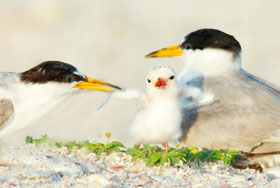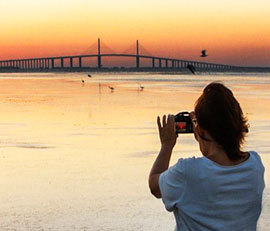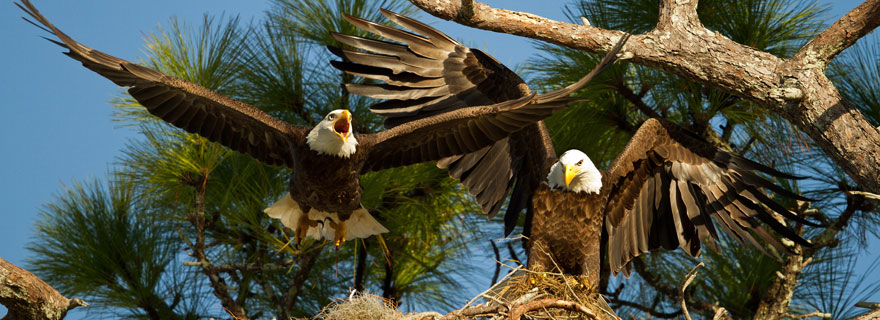
You can find them almost any day, stationed at East Beach before dawn waiting for the sun to cast a scarlet halo over the Skyway Bridge or following “Big Red,” an iconic, taller-than-average reddish egret as he prospects for juicy minnows and crustaceans in the tidal pools.
They are the platoon of photographers, both amateur and professional, who have made the varied vistas of Fort DeSoto Park among the most photographed in Florida. On a daily basis, the core group may number 30 to 50 aficionados, lugging giant telephoto lenses and pricey carbon-fiber tripods.
The images they capture are soothing for the soul – ours and theirs.
“It really is amazing how many different views and images come out of this one little place,” said Jim Wilson, the manager of Fort DeSoto.
Fort DeSoto is not exactly “little.” At 1,136 acres, it is the largest park in the Pinellas County park system, with 328 documented bird species and a sugar-sand beach that was named America’s best in 2005. It is the combination of size and the diversity of habitats and inhabitants it harbors that attracts serious photographers.
“I like to start my day there. It fills me with beautiful things,” said photographer Kathleen Finnerty, who spends part of almost every day there. Finnerty often posts her stunning landscapes on the Friends of Fort DeSoto Facebook page, a showcase for the park’s photographers that has amassed more than 6,000 fans.

Finnerty says the park photographers fall into two basic camps: landscape or scenic specialists, and bird photographers. Oh, and there is that other Great Divide: Nikon versus Canon.
But the regulars all know each other and enjoy an easy camaraderie born of their shared love for a special place they say is like no other. Many are there daily, some even twice a day.
“You can basically see every bird there, except the limpkin, that you can see anywhere else in our area, plus you have the beaches and mangroves and much more,” said Judy Rogero. “There is always something going on. You can find something to shoot all day.”
Unlike Finnerty, who has had a camera in her hand since she was five years old, Rogero didn’t take up photography until 2010, when she retired.
Both have essential attributes for good photography: patience, perseverance and a passion for their subject.
“It starts with the absolute love I have for what I’m taking pictures of,” said Finnerty, “and then it travels to my head and then my eye. I guess it is like looking at the world through another set of eyes.”
Well-known photographic magnets within the park include East Beach, recognized for spectacular sunrise views, and the famed “Mulberry Tree,” which attracts colorful migrating songbirds like orioles, tanagers and buntings every spring and fall. Another popular spot is North Beach, with its beautiful sea oats, dunes and marshes that entice long-legged wading birds.
In addition to the regulars who live in the Tampa Bay area, photographers come from all over the world, many in search of a particular species of bird. Wilson says “Big Red” is the most photographed bird in the park, although this spring a pair of great horned owls and their two chicks are giving Red some competition. The owls nested very low in a tree, probably because the female is blind in one eye, and that made them – and their adorable chicks – very easy to photograph. It also made them easy to harass, and the tree was roped off to keep people from getting too close.

Wilson said it is the photographers who alert park staff to the owl nest each year, so it can be protected. And this highlights an important service they provide, beyond showcasing the beauty of Fort DeSoto. They help educate visitors about the treasures there and how to protect them, and serve as extra eyes and ears, making sure that visitors don’t disturb the wildlife they are there to see.
“I think we have a big responsibility through our encounters with the public to educate them about the park.” Rogero said. “If I see that someone is constantly flushing the birds by running up and down the beach, I can show them through my viewfinder that the birds are panting and explain what that is doing to them.”
Even overzealous photographers need occasional reining in. Wilson said the main problem stems from photographers playing back recorded calls of specific birds to entice them to come out or come closer, where they can be photographed. This causes birds to expend energy needlessly, a hazard especially during migration when birds need to store as much fat as possible.
The regular bunch is quick to police themselves, recognizing the extraordinary jewel they have in such a large and diverse undeveloped area tucked in Florida’s most densely populated county.
“I can go to North Beach and hear the wind whistling through the birds’ wings instead of traffic,” Finnerty said. “Being there starts my day with hope and gratitude for the beauty of nature.”
[su_divider]